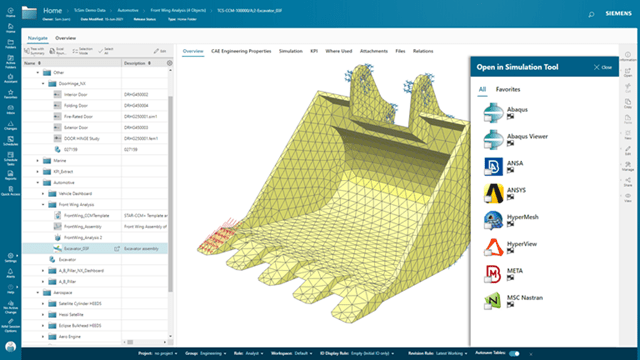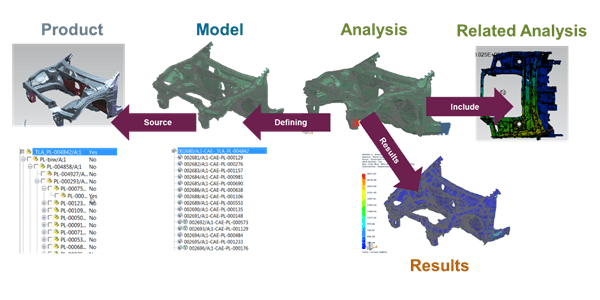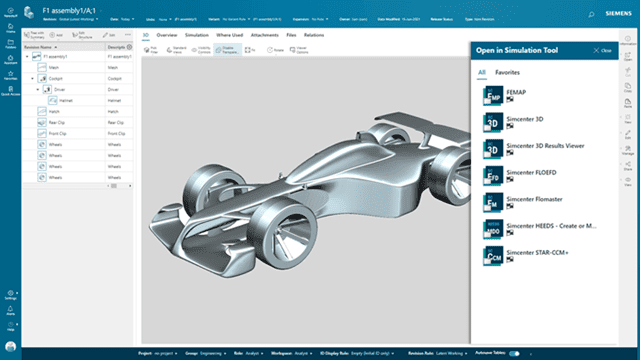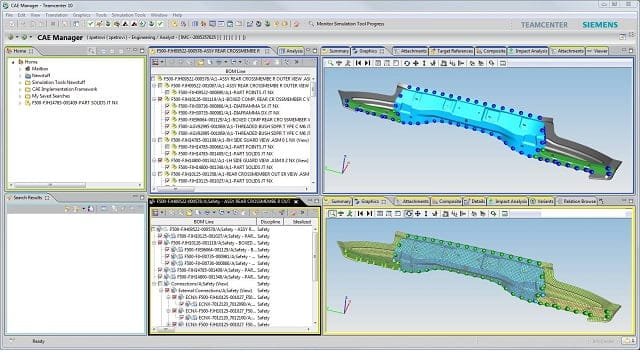Need to Know About a CAE program
There are several factors that are responsible for successful development of modern industrial production. These include cost reduction in the production process, improvement in the quality of the product, and streamlined and accelerated time in the market. A Computer-Aided Engineering (CAE) program is the most effective way to implement these.
What You Need to Know About a CAE program
There are several factors that are responsible for successful development of modern industrial production. These include cost reduction in the production process, improvement in the quality of the product, and streamlined and accelerated time in the market. A Computer-Aided Engineering (CAE) program is the most effective way to implement these.
A CAE program makes it possible to combine engineering modelling simulation with high-performance computing. This not only significantly reduces the cost and time of each cycle of designing, it also saves on development time.
In this way, businesses and organisations are better able to increase the velocity on the path of innovative production and design. By embracing new technologies, such as Simcenter, as well as utilising quality products, and engaging qualified personnel, they get the competitive advantage.

What is a CAE program?
Computer-Aided Engineering (CAE) programs are powerful tools that provide engineering analysis and product simulation. These are highly effective at solving numerous practical tasks. Computer-Aided Design (CAD) is what most industries use when developing new products by using software. A CAE program is the next step in this process.
CAE software solutions are the use of computers and information technologies (ITs) to analyse and synthesise design. The goal of CAE tools is to enable designers to solve more challenging open-ended or integrated real-life design problems. A CAE program is akin to artificial intelligence when it comes to the automation of intelligent behaviours. However, pure creative thinking is as yet still outside of the grasp of CAE tools, and is best left to human designers.
CAE software solutions are not only used in new product development but are also successfully utilised in the engineering process. This is because CAE systems enable tests and simulations to be performed on the physical properties of the product, without the need for physically creating a prototype.
It makes sense to use an easy-to-use CAE software or engineering software as it not only saves time, but reduces the hefty expenses associated with new product design and manufacturing.
The need for CAE software
Design analysis and synthesis can only be performed manually by people on simple objects with ideal application scenarios. Most textbook problems form part of this category.
Instructors use these problems to illustrate physical principles, mathematical models, and solving processes. However, real-world products and systems are usually too complex for manual solutions due to their sophisticated geometric shapes.
For modern products and systems, Computer-Aided Techniques provided through CAE software are an integral part of engineering designs. In traditional machine design, students are taught to calculate physical quantities, such as stress distribution, deflection, and fatigue life, based on dimensions and loading conditions of machine elements.
Although manual calculations are systematic and straightforward, they are very tedious and prone to errors for designers. Furthermore, it is impractical when part geometry becomes complex, or when there is a large number of design candidates in the solution space to evaluate and compare. A CAE application is the ideal engineering and software tool when there are multiple designs and varying constraints, and the best solution needs to be identified.


CAE software and applications support a wide range of engineering phenomena:
Finite element analysis (FEA) to analyse stress and dynamics on components and assemblies
Thermal and fluid analysis through computational fluid dynamics (CFD)
Kinematics and dynamic analysis of mechanisms (multibody dynamics)
FEA or a boundary element method (BEM) to do acoustics analysis
Multi-domain mechatronics system design through 1D CAE, or mechatronic system simulation
Mechanical event simulation (MES)
Analysis of control systems
Modelling and simulation of manufacturing processes such as castings, moulds, and die presses
Improvements to product or process
The Benefits of a CAE Program
A few years ago, Computer-Aided Engineering (CAE) was mainly used to do advanced research, product development, as well as other niched tasks that needed simulation and optimisation.
However, in today’s world, a CAE program has a much wider scope of use. In fact, it is used daily by designers and engineers to facilitate and accelerate the entire product development process.
CAE will become even more sophisticated in the future, enabling designers to model ever more complex designs, as well as reducing the time it takes to build a product.
A smart CAE program, such as Simcenter, not only solves for complex design problems, but it automates much of the drudge calculation work associated with new product design.
This frees up designers to focus on more productive work, as well as provides these compelling benefits:
Instead of physical prototyping, computer simulation can be used to evaluate and refine design candidates.
Using a CAE program can provide performance insights in the early stages of development when making design changes is less expensive.
Engineering teams can manage risk and understand the performance implications of designs using CAE.
By integrating CAE data and processes, a wider community of engineers can benefit from performance insights and improve designs.
By identifying potential problems and eliminating them, a CAE program can help reduce warranty exposure. Also, if properly integrated into product and manufacturing development, it can result in earlier issue resolution, which can bring a dramatic reduction in product life cycle costs.
Data-backed design decisions can be made.


Using a CAE Program for Simulation
Computers were used for product development as early as the 1950s. The idea of these computer programs was to replace drafting boards, protractors, french curves and other drafting tools with engineering software that would make creating and modifying designs simpler.

Fast forward to today, and CAE programs are not only used for design, but also to simulate various scenarios on new designs. This has proven to be enormously valuable when it comes to the validation and perfection of the design of various products.
Example of CAE simulation
For example, simulation through Computer-Aided Engineering (CAE) software has made the need to crash a car repeatedly into a barrier to analyse the results redundant. Rather, engineers can carry out virtual crash tests as many times as they want through highly capable computers and CAE software. They can then optimise designs that will make the vehicle safer. Consider the significant time and financial savings that CAE software offers, all through the power and value of simulation.
Now it is common for engineers to use CAE software like Simcenter for simulations. This is the ideal software on which to create new designs and then optimise through iterative testing and simulations. This allows CAE engineers to improve performance, ergonomics, cost, and affordability. It also ensures new products are manufactured efficiently.
It would be accurate to say that simulations through CAE software are leading the charge when it comes to advancing product development timelines. They are the backbone of countless innovative designs and products that aim to optimise durability, efficiency, and quality.
More sophisticated CAE tools
Due to the emergence of software tools and CAE software that automate all the best design practices in addition to providing sophisticated analysis features, engineers can now focus more and more on high-value tasks.
As a result, product engineering productivity has significantly improved. Development and testing is expedited thanks to engineers no longer needing to manually input data to a system. Consequently, product engineers and CAE engineers are free to create new designs, test and simulate new products, and develop new problem-solving capabilities for products that have a ready market.
The future of Computer-Aided Engineering (CAE)
The emergence of current trends in the world of CAE are expected to grow and continue in the near future. For example, the democratisation of perpetual licences which are currently sold by Computer-Aided Engineering companies. There are a number of try-for-free CAE programs that are available on the market, and many that will allow users to pay as they go. Additionally, cloud computing means that the Computer-Aided Engineering program can be used anywhere, at any time, regardless of the user’s computing device.
System modelling through a CAE program is another trend that is gaining momentum. While it is fairly commonplace for engineers to design and analyse components or assemblies, a full system analysis through a CAE program is rare. However, more CAE professionals are using technology and software to test entire systems. This ensures that performance of the entity as a whole can be analysed. An example might be the case where several discrete assemblies within a maritime vessel are tested to ensure they meet design and operation targets. In the near future, more testing will focus on analysing results from a complete vessel, and its behaviour under various conditions.
Historically, CAE engineers would have to create a new analysis with every new design iteration or new product project. CAE programs of the future may allow engineers to mine historical data from previous simulations. Combined with analytics and automation, they will be able to understand design strengths and weaknesses.
Conclusion
The future of Computer-Aided Engineering (CAE) is bright. Today’s product developers and engineers routinely make use of a Computer-Aided Engineering (CAE) program when they design, develop, and simulate a new product.
This radically cuts down on time, costs, and resources. It also frees up their time to focus on implementing and testing data-driven improvements and analysis. The end result is a product that meets design and operation targets, is cost-effective to manufacture, and ultimately ensures brand protection and loyalty, and greater customer satisfaction.
Modern organisations who want to push the envelope when it comes to innovation and sustainability do well to deploy a Computer-Aided Engineering program and give their designers and developers the tools they need to do more, better.

Customer success and Support

Featured success stories
